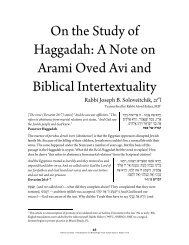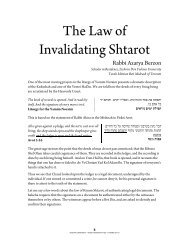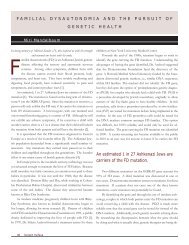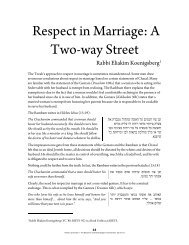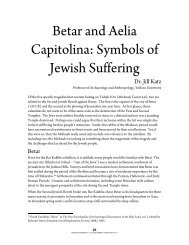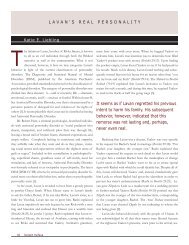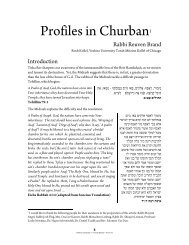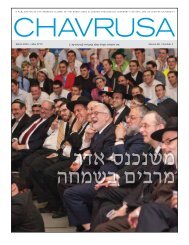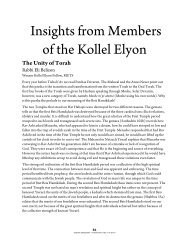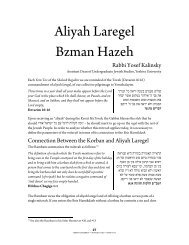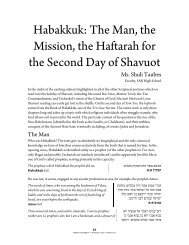YESHIVA UNIVERSITY • SUKKOT TO-GO ... - YU Torah Online
YESHIVA UNIVERSITY • SUKKOT TO-GO ... - YU Torah Online
YESHIVA UNIVERSITY • SUKKOT TO-GO ... - YU Torah Online
Create successful ePaper yourself
Turn your PDF publications into a flip-book with our unique Google optimized e-Paper software.
Zman Simchateinu:<br />
Understanding the<br />
Happiness of Sukkot<br />
Mrs. Chaya Batya Neugroschl<br />
Head of School, Yeshiva University High School for Girls<br />
While the common rabbinic names associated with the Shalosh Regalim are usually clearly<br />
connected to the events they commemorate, with regard to the common name of Sukkot,<br />
referred to as Zman Simchateinu, the connection is less apparent. In addition to the practical<br />
mitzvoth which are unique to Sukkot we have an additional command of Visamachta “and you<br />
shall rejoice.” When it comes to Sukkot we need to wonder, what are the particular roots of this<br />
simcha? How is simcha linked to the events of Sukkot? What joy are we commemorating and<br />
revisiting in our observance of Sukkot? And in turn, how is it that we are able to achieve this<br />
component of the Chag – what does it look like?<br />
Indeed the peshat of the pesukim (Devarim 16:13-16) indicates a very reasonable and natural<br />
explanation for the emphasis on joy during Sukkot. Visamachta can be understood as an<br />
expression of our gratitude for the abundance of our crops and harvest. Although the agricultural<br />
cycle is often connected to the commemorations of the Shalosh Regalim, alone, this does not<br />
characterize the chag and must not be the sole source of Visamachta. An examination of the<br />
meaning of zman simchateinu should, however, include an historical and philosophical<br />
foundation for this aspect of Chag HaSukkot.<br />
The holiday of Sukkot is also characterized by a number of unique commandments,<br />
commemorating the experiences of Klal Yisrael in the midbar. The primary mitzvah is that of<br />
dwelling in Sukkot - temporary dwellings, as mentioned in Vayikra (23: 42-43 ) "In booths you<br />
are to dwell for seven days ...so that your generations will know that I caused the children of<br />
Israel to dwell in booths when I took them from the land of Egypt...." The two components of<br />
the mitzvah are significant to note. Sukkot have a particular form and the chag has a unique<br />
teleological purpose. The Sukkot we build and move into each year are intended to connect us<br />
to a specific period in our nation’s history, when in the desert as a newly liberated nation we<br />
lived in Sukkot.<br />
What these “booths” are referring to is, however, debated in the tractate of Sukkah (11b).<br />
According to Rabbi Eliezer these booths are a reference to the miraculous "Ananai HaKavod,"<br />
36<br />
<strong>YESHIVA</strong> <strong>UNIVERSITY</strong> <strong>•</strong> <strong>SUKKOT</strong> <strong>TO</strong>-<strong>GO</strong> <strong>•</strong> TISHREI 5771



